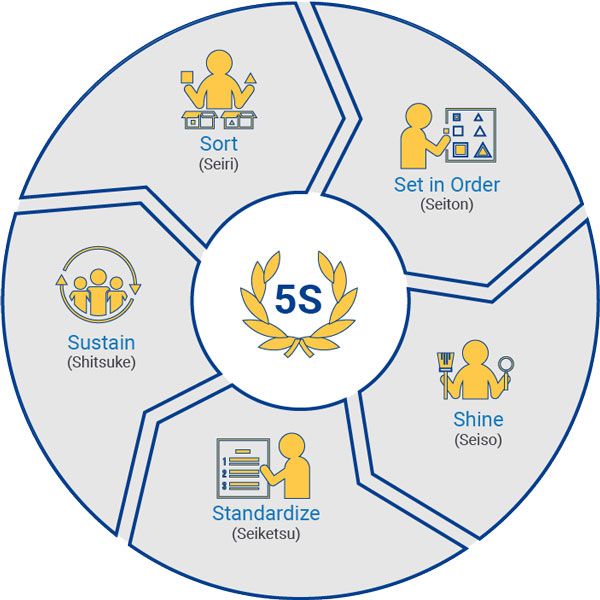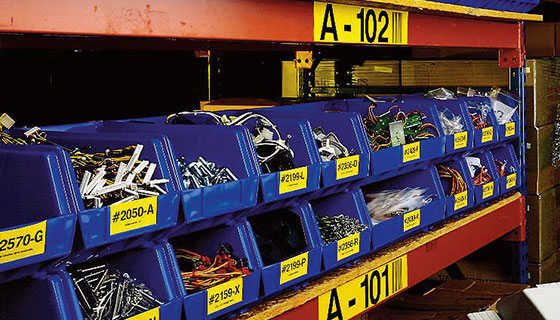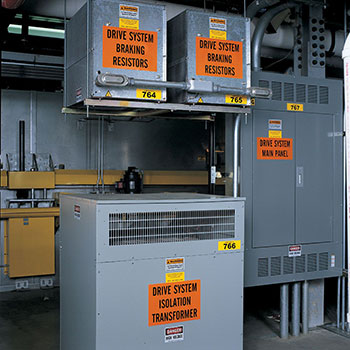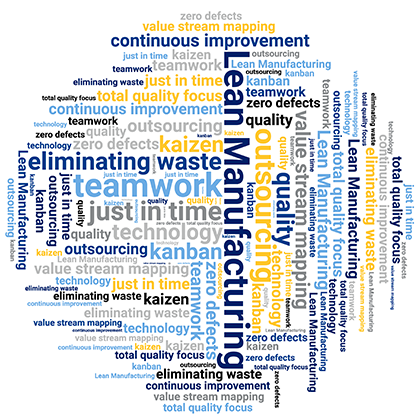Labels for Safety, Visuals and Facility ID Desktop Printers
Labels for Product, Wire and Lab ID Benchtop Printers
Labels for Safety, Visuals and Facility ID Desktop Printers
Labels for Product, Wire and Lab ID Benchtop Printers
Safety and Facility ID Desktop Printers
Product, Wire and Lab ID Benchtop Printers
Barcode Scanners and RFID Readers
PaintStripe Floor Marking Stencils
Valve Lockouts & Hose Lockouts
Group Lock Boxes & Permit Control
Pipe Marker Accessories & Mounting Brackets
Maintenance and Production Tags
Calculators and Assessment Tools
Product Finders and Data Sheets
In business, you’re always looking for smart ways to do more with less while providing the products and services your customers know and love. The concept of “lean” can help your organization do just that, while eliminating waste, optimizing productivity and increasing efficiency.
Lean is a work philosophy that strives to create the most value for the customer at the least cost by maximizing the resources, time, energy and effort involved in creating a product or service.
The lean approach was developed nearly 50 years ago in Japan by the Toyota auto giant. The manufacturing industry was an early adopter of lean principles and practices, but many other industries, including healthcare, government, food and beverage production, and construction, have also implemented it.

Lean moves away from the traditional method of mass production and stockpiling final products in favor of efficient, on-demand production. A lean production system ensures the different stages of production flow in a sequence without interruptions according to a pace of production set by customers’ demands.
But it’s not just about processes and procedures — it also respects the human element within the production system to consider people as more than just capital. With more organizations beyond manufacturing turning to automation to try and solve everyday problems, lean production offers an approach that gives the operators and their work the dignity they deserve.
Five principles guide organizations in lean thinking:
Precisely specify the value of a specific product to the customer.
Map out the value stream for each product, eliminating those that don’t contribute to the creation of value.
Ensure your products or services move towards the customer in a smooth way, with no interruptions, according to value-creating steps that flow in a tight sequence.
Let the customer set the pace for your work.
Pursue perfection by trying to achieve a situation in which value is created with no waste.
5S is one of the most widely adopted lean techniques. This lean manufacturing methodology helps eliminate waste, optimize productivity and increase efficiency. Companies who implement 5s enjoy a cleaner, safer and more organized workplace.

Sorting through materials and tools to determine which are necessary vs. unnecessary, with the intent to remove any unnecessary items from the work area.
Organizing and identifying the remaining necessary materials and tools for ease of use.
Cleaning the area of any dirt and debris. This important step helps to make any other problems, such as leaks or spills, more apparent so they can be addressed to improve safety.
Establishing a daily process to complete the sort, set in order and shine pillars. This ensures you maintain the cleanliness and order created during the initial 5S event.
Turning 5S into a habit to sustain the initial gains in productivity and safety, while also maintaining waste reduction efforts.
A key tenet of lean is reducing or eliminating waste, also known as “muda.” Waste is defined as the steps or actions within a process that aren’t required to complete a process (called “non value-adding”). These elements include:
A Total Productive Maintenance (TPM) system ensures machines run optimally by leveraging predictive analytics to anticipate problems before they occur. TPM helps eliminate waste caused by accidents, emergency and unscheduled downtime, defects and speed losses.
Three different types of maintenance are combined with TPM, including autonomous maintenance, preventive maintenance and early equipment maintenance. Preventive maintenance is particularly important in a lean process, as it seeks to prevent the need for maintenance and introduces methods to monitor critical areas that require real-time attention.

Implementing safety and facility identification products will help you navigate the entire lean transformation to create a safer, more efficient workplace through visuals.
In a visual workplace, critical information is conveyed through visual devices, positioned at the point of need that can be understood at a glance. Because visuals are easy to understand, an effective visual workplace can improve safety by reinforcing training, while eliminating downtime that had previously been spent searching, asking, or waiting for information. Organizations that have incorporated lean / 5S visuals into an effective visual workplace system experience a number of benefits:
See 50 tried-and-true ways to effectively use visuals throughout your facility. These examples can help you get started in creating your own visuals — and take the first steps to transforming your facility into a lean workplace!


“Production. Preparation. Process.” is a method to achieve transformational changes in production process through rapid, integrated prototyping of both product and process.
One of the most widely adopted lean techniques, 5S incorporates five components that help eliminate waste, optimize productivity and increase efficiency.
A lean methodology that adds another critical aspect of any workplace – safety – to the 5S principles of lean.
A problem-solving process that results in a report that summarizes the problem, analysis, and the corrective action plan on a single sheet of large (A3) paper, often with the use of graphics.
A large lighted board used to alert floor supervisors to a problem at a specific station.
A five-step methodology that defines the Six Sigma approach to lean:
A technique that determines the root cause of a problem by repeating the question "Why?", usually five times, to uncover a flawed process that can be improved to help resolve the problem.
The actual place where the real work is done; on-site.
To recognize and reflect on mistakes, and to commit to take appropriate action to avoid re-occurrence.
A lean method for reducing the unevenness in a production process and minimizing the chance of overburden. It can help people react to demand changes and maximize capacity.
A method for ensuring that the strategic goals of a company drive progress and action at every level within that company to eliminate waste from inconsistent direction and poor communication.
A fundamental lean principle that means “automation with a human touch.” An andon is an example of this concept.
A manufacturing methodology from the Toyota Production System (TPS) to reduce times within the production system, as well as response times from suppliers and to customers.
Sign or index card. As the most well-known approach for implementing a pull system, the Kanban card system provides a sign or signal by the next step in the process or downstream operation.
The set of tools and techniques used to streamline and improve a company’s production system, to ultimately boost productivity while reducing waste.
Waste. Muda Type 1 includes non-value-added activities in the processes that are necessary for the end customer. Muda Type 2 includes non-value-added activities that are unnecessary for the customer and should be eliminated.
Overburden to employees or equipment. This exists when machines or operators are utilized for more than 100% capability to complete a task, or in an unsustainable way.
The smooth production or service flow of both materials and information.
A tool for facilitating teamwork and better managing projects. Literally translates to “manager's meeting” or “war room.”
When items or services are processed in one piece at a time, moving items directly from one process step to the next one piece at a time, to reduce lead times and improve quality by exposing abnormalities in processes. The concept behind a JIT system.
Making products in too great a quantity or before they’re needed by customers, leading to excessive inventory. Often considered the worst of the seven “mudas.”
A continuous loop of actions that provides a simple and effective approach for solving problems and managing change.
A flow plan of all material that moves through a manufacturing plant, including specific data on every part number coming from suppliers and every product SKU going to customers.
Any mechanism in a lean manufacturing process that helps to avoid mistakes or eliminate product defects by preventing, correcting, or drawing attention to human errors as they occur.
A lean manufacturing strategy that fulfills orders when customers want them and produces items in small quantities, allowing quality issues to be identified quickly.
A system that bases production on a projected production plan. This is how many traditional production lines have operated.
A data-based approach that improves business processes through statistical analysis to control variation and develop more predictable and profitable processes.
The seven categories of waste under Muda Type 2:
An integrated system developed by the Toyota car company that organizes manufacturing, logistics, and interaction with suppliers and customers. The precursor of lean manufacturing.
A part of the lean manufacturing process that uses signs, labels, charts, infographics, and other communication tools to provide data in an efficient manner.
A motivated workforce that increases workforce flexibility and agility to improve the bottom line.
A lean tool that documents the current best practice and forms the baseline for kaizen or continuous improvement. As the standard is improved, the new standard becomes the baseline for further improvements.
A process for sharing learning laterally across an organization, peer to peer.
Support your lean and reliability initiatives with pre-printed and custom lean 5S labels backed by more than 100 years of label innovation. Lean labels are a great way to motivate your employees in their lean initiatives. They can be applied around the facility to reinforce the principles of lean performance, maximum uptime and overall efficiency. Printable and pre-printed labels are available with many different legend options to accommodate a range of lean practices.